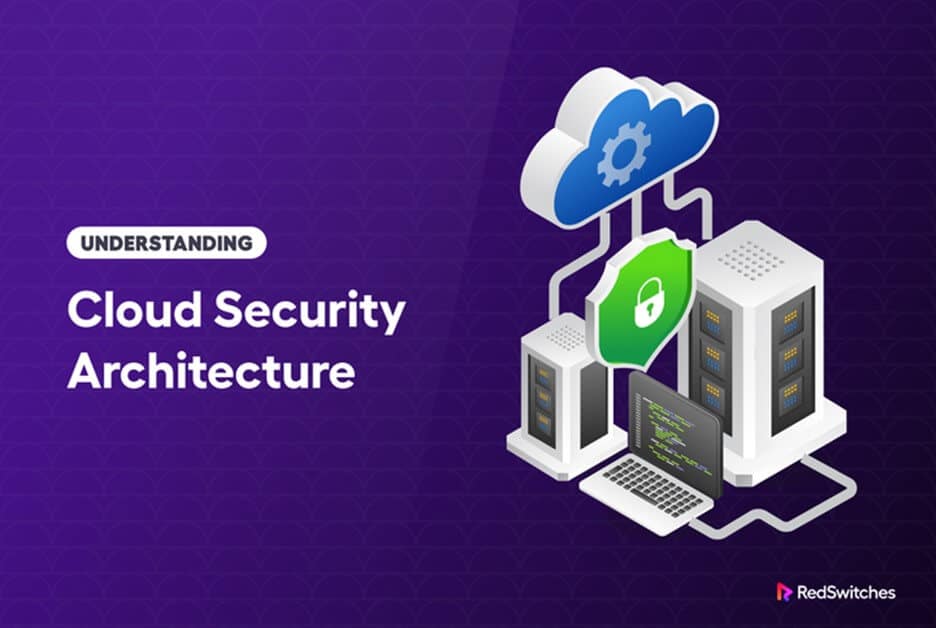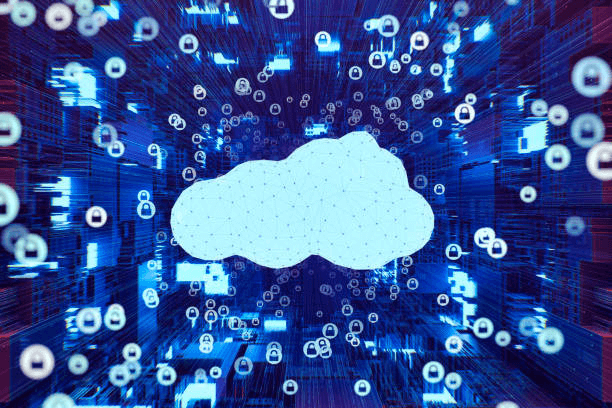What is the best way for businesses to safeguard their data when they migrate from on-premise data centers? It is one essential question that businesses should ask themselves when moving to the cloud, and here’s why. Businesses commonly store their data on remote servers that are vulnerable to cyber-attacks. The good news is that Cloud security architecture can quickly fix this challenge.
Cloud computing security architecture, in its nature, provides protection measures to apps, cloud platforms, and data, often through encryption against breach or damage. It is one of the fundamental factors to consider in any cloud strategy that guarantees data protection.
So, this guide will examine the significance of cloud security architecture in cloud computing, the execution of best practices, and the vital components. We’ll also explore the types of cloud architecture, the shared responsibility model, and much more. The goal of this article is to help you understand the architecture of cloud security and the role it plays.
Table of Content
- What Is Cloud Security Architecture?
- Understanding Cloud Security Alliance (CSA) Model
- Understanding Data Security
- Why Is Cloud Architecture Important?
- Key Elements of Cloud Security Architecture
- Service Models of Cloud Security Architecture
- 3 Security Principles for a Cloud Architecture
- What Are Some of the Threats to Cloud Architecture?
- Cloud Security Architecture and Shared Responsibility Model
- Key Takeaways
What Is Cloud Security Architecture?
The technology and infrastructure protect systems and data in cloud platforms. Creating a cloud security architecture follows a process. It begins with a map, progresses to development, and finally integrates it into the cloud system.
The architecture’s main objective is to provide privacy and maintain the integrity of cloud infrastructure through encryption, firewalls, and other protection measures.
Understanding Cloud Security Alliance (CSA) Model
The Cloud Security Alliance (CSA) is a not-for-profit institution that promotes safe cloud computing practices. Founded in 2008, this organization offers chapters in over 90 countries. Some of its members are service providers and users looking to improve the cloud computing security architecture framework.
The CSA created the Cloud Control Matrix (CCM). It’s a collection of security standards that companies can use to assess the safety of their cloud environment.
The CCM is a comprehensive and uniform approach for evaluating the security of cloud services. In addition, it relies on industry-accepted security standards and laws.
CCM divides every domain into several individual controls, where each control adheres to different security guidelines and statutes. Good examples include ISO 27001, PCI DSS, and HIPAA. Given that the CCM is adaptable, companies can select the controls related to their needs and compliance requirements.
The Cloud Security Alliance (CSA) also provides additional data and resources for helping enterprises strengthen their cloud security. A good example is the Cloud Control Matrix (CCM) assessment tool. It enables organizations to evaluate their compliance with the CCM regulations.
The CSA has created additional security models besides the CCM, such as Security Trust and Assurance Registration (STAR). It’s a compliance body for service providers that assess their cloud protection protocols. For experts that work in the field of cloud security, the CSA also provides training and certification programs.
Businesses looking forward to strengthening their architecture of cloud security should consider Cloud Security Alliance a valuable resource. The CSA helps businesses avoid the risks associated with cloud computing and confidently employ cloud services.
Understanding Data Security
Data security protects info from theft, destruction, or breach. It can encompass every part of data security, such as infrastructure, access controls, etc. Some of the standard aspects of data security include:
1. User Verification
It’s the process of proofing the user’s identity. It helps guarantee that only authorized users can access the cloud system. Some common ways a user can verify themselves is through biometrics or a password.
On the other hand, a key agreement describes the creation of a “secret key” for secure communication between two entities. It works by encrypting or interpreting data which guarantees privacy.
2. Record Auditing
It’s the process of recording all occurrences in a cloud system. Data security depends on record auditing because it helps detect risk, and the administrator can implement risk management protocols. This type of risk mitigation strategy is handy when handling sensitive data. In addition, it helps in complying with industry guidelines.
3. Accreditation
Evaluating a security system and ensuring it follows regulations is what “accreditation” means. The procedure commonly involves standard criteria, ISO 27001, and more. The process is crucial for businesses in assessing their system security framework.
4. Power
Power failure and outages are a risk to data security. It can cause massive data loss and destruction of resources. Companies can employ redundant measures like backup power systems to help protect resources and data corruption.
Having a comprehensive strategy for tackling these risks is crucial to all organizations. It can help to hold customer confidence and guarantee data safety.
Why Is Cloud Architecture Important?
There is a need for organizations to have a solid basis to appreciate the cloud’s prospects. Cloud architecture security offers precisely that. The cloud depends on its architecture because it provides stability and security. The common types of cloud computing are:
- Public cloud
- Private Cloud
- Hybrid cloud
Cloud architecture also provides revolutionary advantages to companies where they can transform and adjust to the business environment.
The drawback to the cloud is the risk of hacking and cyber threat. The good thing is cloud security architecture design safeguards the underlying framework in such scenarios. It is where businesses can exploit the cloud benefits. Some of these are IaaS, PaaS, and SaaS while protecting the system against cyber threats.
Ultimately, businesses need to have a solid cloud security architecture plan. In addition, the cloud security architecture is all about integrating security measures into the overall design of the architecture.
Key Elements of Cloud Security Architecture
The key elements of cloud architecture and security that companies need to ensure the security of their cloud resource include:
1. Cloud Security Posture Management
It is one of the critical parts of cloud architecture security. It refers to maintaining and overseeing the security posture of the cloud environment. The CSPM tools help companies find and fix potential security issues promptly. Good examples include unauthorized access or misconfigured servers. Application of CSPM by companies can help them adhere their cloud environments to industry best practices and regulations.
2. Cloud Workload Protection
It is another essential component of security architecture design in cloud computing. It refers to the securing of applications and workloads in a cloud environment. Good examples include containers, serverless applications, and more. The good thing about CWP tools is that they can detect and mitigate the risks associated with cyber threats like malware. The application of these tools can help firms safeguard their workloads from breaches.
3. Cloud Access Security Broker
It is a process that provides clarity and control over a cloud application. These tools are crucial in cloud computing because they execute security measures in all cloud frameworks.
Another thing is the tools can identify and curb any data theft. So, any business looking to streamline its security system in the cloud should implement the cloud access security broker tools.
4. Cloud Application Security
Its primary focus is on cloud application security and one of the crucial components of cloud computing security architecture. The CAS benefit is that it can help businesses find real-time cyber threats and oversee cloud resources.
A common cyber risk is cross-site scripting which a CAS solution can help detect and safeguard the cloud resource from. So businesses looking to protect customer data and maintain their systems’ integrity will find the CAS tool incredibly valuable.
Service Models of Cloud Security Architecture
The common models of the cloud come with distinct security measures and protocols, and they are:
1. SaaS Security Architecture
The primary goal of this cloud model is to protect customer data. The infrastructure the solution runs on is under a third-party service provider. They are in charge of the upkeep and provision of easy access to the cloud for the client. The customer needs to put some security measures on their end for data protection. It can be through a password or biometric access. Common SaaS security architecture elements are:
- Data encryption for security.
- Access security controls such as firewalls.
- Risk detection and management.
2. PaaS Security Architecture
This cloud model aims to protect the underlying platform, which helps create and launch apps. Often, this model runs on infrastructure under a cloud service provider. They are in charge of maintaining and providing the end user easy access to the cloud. Conversely, the customer is responsible for securing the applications they create through the platform. Common PaaS security architecture elements are:
- Programming and regular access security testing.
- Risk detection and management.
- Data encryption and protection along with communication privacy.
- User access verification and management.
3. IaaS Security Architecture
Its primary focus is safeguarding the infrastructure that supports deploying and managing networks, virtual machines, and storage. The service providers are in charge of the infrastructure. On the other hand, the user is in charge of the data and apps they deploy on the infrastructure. Some of the components of IaaS security architecture include:
- Host security controls like intrusion prevention systems, antivirus, and more.
- Threat detection and risk management
- Data protection and encrypting of sensitive communications and data
- Access control management for the user during verification.
Any company migrating or already in the cloud should consider a security architecture design framework in cloud computing. Understanding the security requirements of each service model can help companies create an in-depth architecture that offers ultimate protection.
3 Security Principles for a Cloud Architecture
Companies must consider three common cloud architecture principles to ensure their cloud environments’ safety. They include:
1. Accessibility
It offers flexibility by incorporating a user’s needs. Many can access these resources without issues, regardless of users’ limitations. The drawback to this is the vulnerability to data breaches or hacking. The good news is that most service providers employ protection measures like firewalls and encryption to secure your data.
2. Integrity
Encryption is one-way users can guarantee data privacy in cloud environments. The continuous protection of customer data and the fidelity of the cloud platform is what integrity means. Some other ways businesses can continue safeguarding cloud resources are by applying backup and disaster recovery measures.
3. Availability
Having quick access to your data is essential in a business setting. One thing that can derail your company’s operations is downtime. In a cloud setting, downtime can lead to security risks, such as service (DDoS) attacks.
So, to mitigate such risks, companies need to implement redundant strategies to guarantee high levels of cloud availability. Not only that, businesses should continuously test and evaluate their strategy to ensure they are reliable.
The above three cloud architecture and security concepts are crucial to a business’s success. They can help in safeguarding and ensuring the availability of the cloud resource.
What Are Some of the Threats to Cloud Architecture?
Some of the most common risks associated with cloud architecture include:
1. Insider Risks
Insider risk is a common threat to the cloud. It happens when a staff member gets access controls to the servers and leaks out sensitive data from the resources. The risk can be in many forms. Some examples include exploitation, theft, etc. Some of the ways companies can safeguard cloud resources are through training the staff on security protocols or administering access controls.
2. Shadow IT
When company staff illegally get access to the cloud servers with no approval, that’s what shadow IT means. The risks associated with it include compliance violations, breaches, and more. Some of the methods a business can use to protect data are by applying stringent cloud use. One way for companies to mitigate shadow IT is by implementing strict cloud usage policies. In addition, monitor cloud usage and provide employees with approved cloud services and applications.
3. Lack of Comprehensive Cloud Security Strategy
The cloud needs more advanced security protocols than on-premise servers. That’s why an admin needs to learn a new cloud security strategy that adheres to modern standards. So, businesses need the proper knowledge and expertise to know cloud security challenges.
4. Availability of Data
Availability of data refers to the ability to access data when needed. A lack of availability can result in lost productivity and revenue and damage a business’s reputation. Companies can mitigate this threat by implementing redundancy and failover mechanisms. They ensure users can access data in case of an outage or failure.
5. Human Error and Misconfiguration
When building business apps, human error is a common risk. One way to reduce these errors is by implementing robust controls to help decision-making. Misconfigurations happen because users hop from one provider to the next. Since each provider uses different configurations, the service will have a unique implementation.
6. Visibility
A company’s cloud resources often run on infrastructure they don’t own and are located outside their network. So, lack of visibility can be a significant concern for businesses that store sensitive data. Some of the ways companies can improve their visibility are by adding login protocols and monitoring access controls.
Cloud Security Architecture and Shared Responsibility Model
Here is a table to explain cloud computing security architecture and the shared responsibility model.
| Responsibility | Cloud Customer | Cloud Service Provider |
| Application and Device Configuration | Yes | No |
| Application Security | No | Yes |
| Configuration and Risk Management | Yes | No |
| Compliance and Auditing | Partial | Partial |
| Data Security | No | Yes |
| Data Protection | Yes | No |
| Host Security | No | Yes |
| Network Security | No | Yes |
| Physical Security of Infrastructure | No | Yes |
A unified effort from both the service provider and end-user is crucial. The good thing is that shared responsibility enhances that collaboration.
Key Takeaways
- Cloud computing security architectures are procedures and principles that help safeguard the cloud from breaches or hacking.
- Encryption, access controls, and network security are essential components of cloud architecture security.
- Some security concepts companies can employ to safeguard their cloud resources include ethics, privacy, and reliability.
- The cloud security architecture design is essential in understanding the shared responsibility model. The reason being it lays out customer and service provider roles.
- The risks that can affect cloud architecture come in many forms. Some of the most common are misconfiguration, DDoS attacks, insider threats, lack of a solid security protocol, human error, and more.
- Some measures are necessary to maintain a robust cloud architecture. They include incident response planning, regular security evaluation, and penetration tests.
Check out our resources section to learn more about cloud security architecture and how it can improve your business operations.



